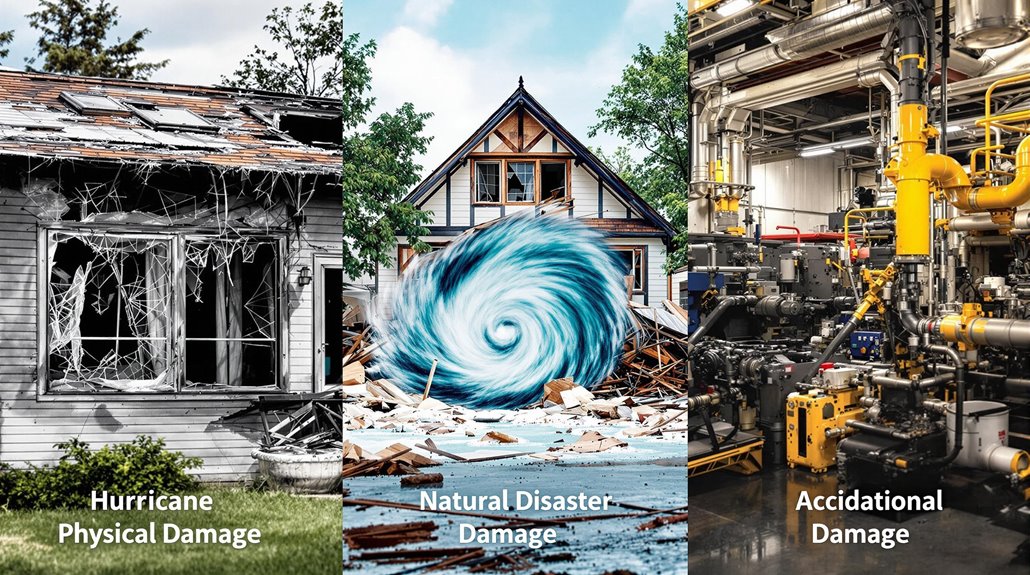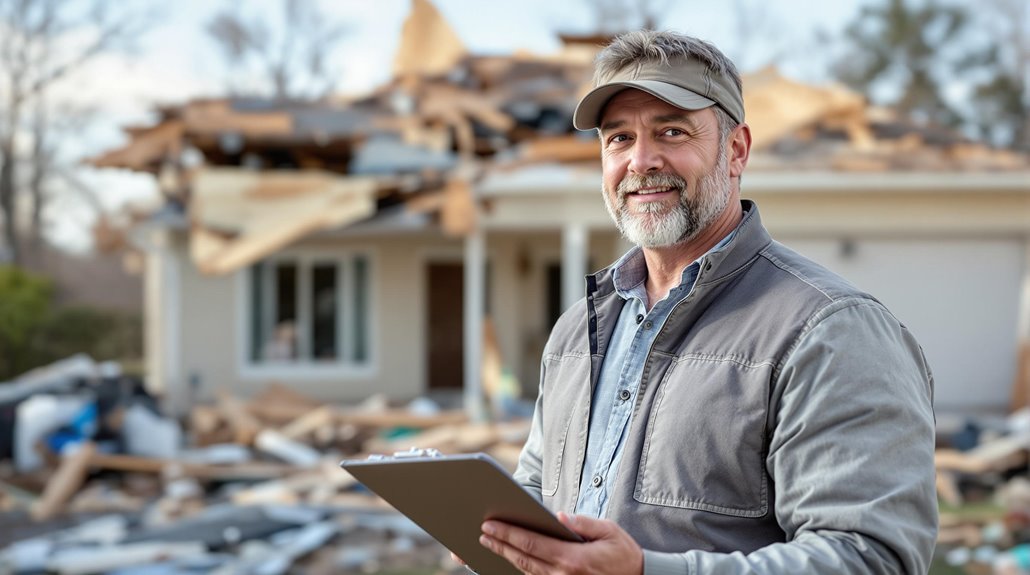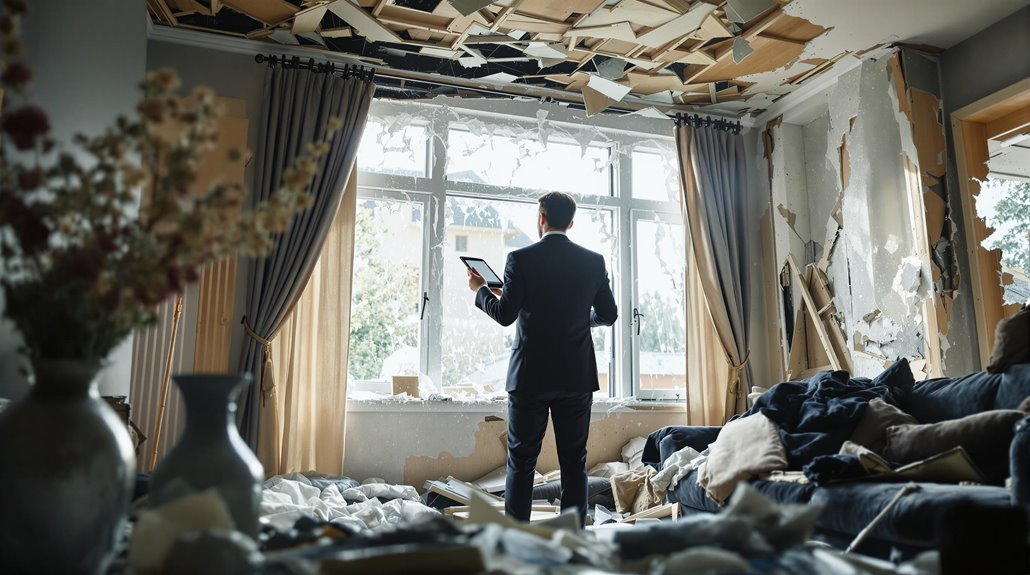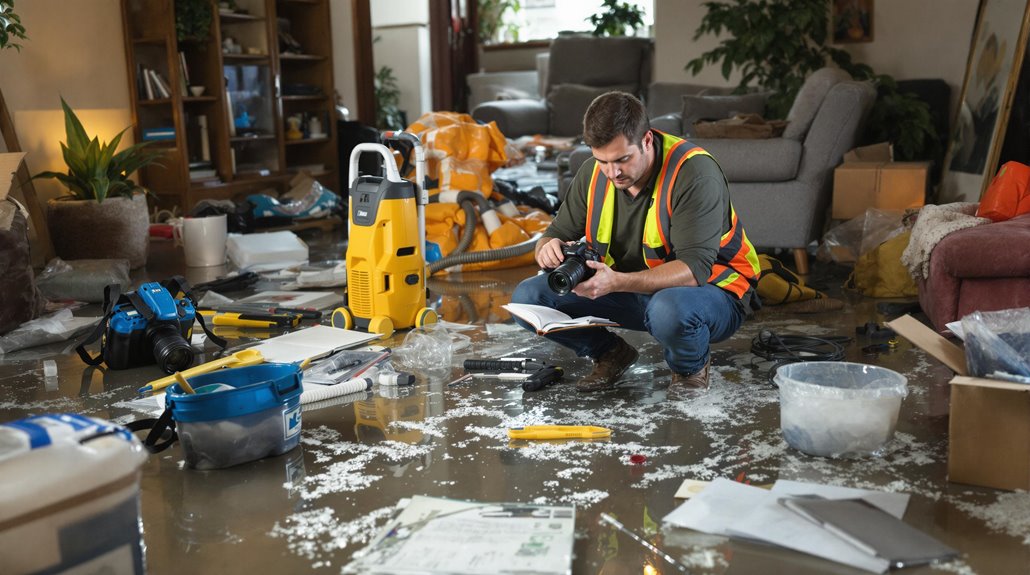The property damage insurance claims process is a formal procedure between policyholders and insurers to determine fair compensation for losses incurred. It involves notification, documentation, assessment, and evaluation of damage to physical assets, such as buildings and personal belongings. Policyholders must notify insurers within 24-48 hours of discovery and provide written proof of loss within 60 days. Understanding the process and its requirements is essential for a successful claim. Further insight into the process can provide policyholders with a clearer understanding of what to expect.
Key Takeaways
- Property damage insurance claims involve a formal procedure between policyholder and insurer, requiring initial notification and documentation.
- Insurance adjusters assess and evaluate damage, reviewing policy coverages and deductibles to determine fair compensation.
- Policyholders must report incidents with detailed documentation, complete adjuster inspections, and secure damaged property to prevent deterioration.
- Time limits apply, including notification within 24-48 hours, written proof of loss within 60 days, and additional damage reporting within 180 days.
- Professional representation, such as public adjusters or lawyers, can significantly increase settlement amounts, but may come with contingency fees.
What Is Considered Property Damage?
Property damage encompasses a broad range of losses, including destruction or deterioration of physical assets such as buildings, homes, and personal belongings.
When filing an insurance claim, it is essential to understand what constitutes property damage to guarantee accurate documentation and coverage.
- Damaged property can include tangible items such as:
- Furniture, appliances, and electronics
- Clothing, jewelry, and other personal effects
- Vehicles, boats, and other recreational equipment
- Buildings, structures, and other real estate holdings
In the context of an insurance claim, property damage can result from various causes, including natural disasters, accidents, or intentional acts.
Claims with professional representation typically result in settlements that are 574% higher compared to unrepresented claims.
Policyholders should carefully review their policy to understand what types of property damage are covered and what exclusions or limitations may apply. Accurate documentation of damaged property is vital to support an insurance claim and guarantee fair compensation for losses incurred.
4 Major Classifications Of Property Damage

When evaluating damage to assets, it is essential to categorize the type of harm inflicted, as this classification plays a significant role in determining insurance coverage and compensation. Property damage can be broadly classified into several categories, which help the insurance company to assess the claim.
| Damage Classification | Description |
|---|---|
| Physical Damage | Direct harm to structures or contents through forces like fire, water, wind, or impact. |
| Natural Disaster Damage | Destruction from events like floods, earthquakes, hurricanes, tornadoes, and severe storms. |
| Accidental Damage | Unintentional harm from events like equipment malfunctions, chemical spills, or operator errors. |
These classifications aid in determining the validity and extent of a property damage insurance claim. Insurance companies use these categories to assess the claim and provide compensation accordingly. The classification also affects the processing of the claim, making it essential to understand the type of damage inflicted on the property. For homeowners in designated flood zones, it's concerning that only 27% have flood insurance despite the significant risk of water damage.
What Is Property Damage Insurance Coverage?

Property damage insurance coverage encompasses various types of protection for individuals and businesses.
Understanding the nuances of property damage liability coverage is essential for handling the complexities of property damage insurance claims.
Effective management of these claims requires familiarity with key aspects of property damage insurance coverage, including:
- Types of property damage coverage, such as flood, fire, and theft
- Property damage liability coverage and its implications for policyholders
- Potential exclusions and limitations of property damage insurance policies
- Procedures for calculating and settling property damage insurance claims
Most policies require meeting a property insurance deductible before coverage benefits can be activated for eligible claims.
Types Of Property Damage Coverage
Under the umbrella of property insurance, various types of coverage are designed to protect homeowners and businesses from the financial burden of property damage. These coverage types enable policyholders to rebuild, repair, or replace damaged properties, minimizing financial losses. Understanding the different types of property damage coverage is essential for selecting the right insurance policy and maximizing insurance claims. Working with public adjusters can help ensure fair settlements for complex property damage claims.
| Coverage Type | Description | Typical Coverage Limits |
|---|---|---|
| Dwelling Coverage | Covers damage to the building structure | Up to the policy's face value |
| Personal Property Coverage | Covers damage to personal belongings | 50-70% of dwelling coverage |
| Scheduled Personal Property Coverage | Covers valuable items, such as jewelry or art | Item-specific, as scheduled |
| Flood Insurance Coverage | Covers damage caused by flooding | Varies, depending on location |
| Earthquake Insurance Coverage | Covers damage caused by earthquakes | Varies, depending on location and risk |
What Is Property Damage Liability Coverage?
Typically, liability insurance policies include a provision for property damage liability coverage, which safeguards the insured party against financial losses resulting from damage to others' properties. This type of coverage is essential for individuals and businesses that may be held liable for damages to third-party properties. Understanding personal liability coverage exclusions helps policyholders identify potential gaps in their insurance protection.
| Coverage | Description | Example |
|---|---|---|
| Property Damage Liability | Covers damages to third-party properties | A contractor accidentally damages a client's building |
| Collision Coverage | Covers damages to insured's vehicle | A driver collides with another vehicle |
| All-Risk Coverage | Covers non-collision damages to insured's vehicle | A vehicle is damaged in a hail storm |
| Property Damage Claims | Involves submitting claims to insurance company for damaged properties | A homeowner submits a claim for damaged roof |
In the event of property damage claims, the insurance company will assess the damages and provide compensation accordingly, based on the property damage insurance policy terms.
What Is A Property Damage Claim?

Submission of a property damage claim marks the beginning of a formal process between a policyholder and their insurance company. This process seeks to provide compensation for physical damage or loss to covered property assets.
A property damage claim initiates a structured procedure requiring documentation of damages, professional assessment, and negotiation between the policyholder and insurer for settlement.
Key aspects of a property damage claim include:
- A formal request for compensation due to physical damage or loss to covered property assets
- A structured process involving damage assessment, documentation, and negotiation
- Coverage for various types of losses, including structural damage, equipment losses, and content destruction
- A requirement to demonstrate that the loss occurred during the policy period and was caused by a covered peril
The insurance company's claims process typically requires proof of ownership, evidence of damage, cost estimates for repairs, and compliance with policy-specific reporting timeframes.
Working with public adjusters can increase property damage claim settlements by 30-50% compared to handling claims independently.
Types Of Property Damage Claims

Numerous types of property damage claims exist, each with distinct characteristics and requirements. Understanding these differences is essential for handling the claims process effectively. Property claims can arise from various sources, including natural disasters, accidents, and intentional acts.
| Claim Type | Description |
|---|---|
| Catastrophic Claims | Large-scale damages from events like hurricanes, wildfires, or floods. |
| Theft Claims | Stolen or vandalized property, requiring detailed documentation of damaged items. |
| Liability Claims | Damages caused by the policyholder's actions or negligence. |
| Maintenance-Related Claims | Damages resulting from lack of maintenance or wear and tear. |
Insurance adjusters will assess the damage and determine the extent of coverage under the property insurance policy. To guarantee fair compensation, policyholders must provide thorough documentation of the damage and losses. By understanding the specific requirements of each claim type, policyholders can better handle the claims process and achieve a fair settlement. Claims management systems help adjusters streamline the evaluation process and maintain accurate documentation of property damage cases.
Understanding The Property Damage Insurance Claims Process

The property damage insurance claims process involves a series of complex steps, from initial notification to final settlement.
To navigate this process effectively, policyholders must understand the procedures for handling property damage claims, including the importance of prompt reporting and thorough documentation.
The following key aspects of the claims process are essential to examine:
- Notification and documentation requirements, including time limits for filing claims
- Assessment and evaluation of damages by insurance adjusters
- Review of policy coverages, deductibles, and potential disputes over claim amounts
- Strategies for negotiating fair settlements and expediting the claims process
During emergency situations like flooding, professional water removal and proper documentation of all mitigation efforts are critical steps for claim approval.
How To Handle Property Damage Claims
Most property owners are unfamiliar with the intricacies of filing a property damage insurance claim, which can be a lengthy and complex process.
The claim process typically involves reporting the incident to the insurance company with detailed documentation, including photos, videos, and a thorough inventory of all damaged items. An adjuster inspection, damage assessment, coverage review, repair cost estimation, and final settlement negotiation follow, often taking several months to complete.
To facilitate a smooth process, policyholders should secure the damaged property to prevent further deterioration while maintaining all evidence and documentation until the insurance company completes their investigation. Effective communication and thorough documentation are essential in ensuring fair compensation based on policy coverage limits and actual repair costs. Studies show that claims handled by public adjusters result in settlements up to 800% higher compared to those without professional representation.
Property Damage Claim Time Limits
Filing a property damage insurance claim is subject to various time limits, which policyholders must navigate to safeguard coverage eligibility and avoid potential denial. Notifying your insurance company as soon as possible is critical, typically within 24-48 hours of discovering damage.
Policyholders must also adhere to the time limit for submitting written proof of loss documentation, usually within 60 days of the insurance company's request. Additionally, policyholders have 180 days to identify and report additional damage.
To avoid complications, it is essential to contact your insurance company promptly and understand the specific time limits outlined in your policy. Failing to meet these deadlines may result in claim denial or reduced settlement amounts. Understanding these time limits is imperative to secure a smooth and successful claims process. Working with public adjusters can help maximize settlement amounts by increasing payouts up to 50% over initial offers.
Property Damage Claims Public Adjuster Vs. Lawyer

When handling the complexities of property damage insurance claims, policyholders often consider seeking professional assistance from either public adjusters or lawyers. The choice between these two options depends on the specific circumstances of the claim, including the nature of the damage, policy coverage, and potential disputes with the insurance company. The following table highlights key differences between public adjusters and lawyers in handling property damage claims.
| Public Adjuster | Lawyer |
|---|---|
| 7-10% of claim settlement (typical fee) | 30-40% of recovery (contingency fee) |
| Focus on claim valuation and negotiation | Focus on legal action and litigation |
| Expertise in damage assessment and policy interpretation | Expertise in legal enforcement of policy rights and court representation |
| Suitable for straightforward property damage claims | Suitable for complex claims involving bad faith, coverage disputes, or liability issues |
| Immediately begins working on claim documentation and valuation | Typically becomes involved after claim disputes or denials occur |
Property Damage Claim Public Adjusters
A policyholder's decision to hire a public adjuster or a lawyer for a property damage claim often hinges on the nature of the dispute and the desired outcome.
When the dispute primarily involves claim valuation and negotiation, hiring a public adjuster may be the preferred choice. Public adjusters specialize in evaluating property damage, using estimating software to calculate repair costs, and negotiating directly with insurance companies to settle claims.
They typically charge 7-10% of the claim settlement, which is lower than the contingency fees charged by attorneys. By hiring a public adjuster, policyholders can effectively navigate the claims process and guarantee they receive a fair settlement for their property damage. This option is particularly beneficial for policyholders seeking to settle their claim without resorting to litigation.
Property Damage Claim Lawyers
Property damage claim lawyers offer a distinct set of skills and services compared to public adjusters, making them a viable option for policyholders facing complex or disputed claims.
Unlike public adjusters, lawyers can file lawsuits and represent clients in court proceedings, providing a higher level of advocacy when dealing with resistant insurance companies.
Working on contingency fees of 25-40% of the claim recovery, lawyers bring specialized expertise in interpreting complex policy language and protecting policyholders' legal rights. They are particularly valuable when claims are denied, delayed, or when bad faith insurance practices are suspected.
Does Homeowners Insurance Cover Damage To Neighbors Property?

Most standard homeowners insurance policies include liability coverage, which may help protect policyholders from financial losses if they are found responsible for damaging their neighbor's property. This coverage typically pays for damages to the neighbor's property, as well as any related medical expenses if the neighbor is injured.
| Scenario | Coverage |
|---|---|
| Policyholder accidentally starts a fire that damages neighbor's house | Liability coverage may pay for damages to neighbor's house |
| Policyholder's fallen tree branch damages neighbor's fence | Liability coverage may pay for damages to neighbor's fence |
| Policyholder is not found responsible for damaging neighbor's property | Liability coverage does not apply |
| Neighbor damages policyholder's property | Policyholder's homeowners policy may cover damage to their own property, but not neighbor's |
It is essential for property owners to review their homeowners policy to understand what is covered and what is not. They should also inform their insurance company promptly in case of damage to their neighbor's property.
Frequently Asked Questions
What Are the 4 Stages of the Insurance Claim Process?
The four stages of the insurance claim process are:
(1) claim notification and initial assessment, where the policyholder notifies the insurer and provides preliminary damage information;
(2) damage evaluation and documentation, involving on-site inspections and evidence collection;
(3) claim processing and review, where the insurer assesses policy coverage and calculates settlement amounts;
and (4) settlement negotiation and resolution, where the policyholder and insurer agree on a final claim payout.
What Are the 4 Major Classification of Property Damage?
Ironically, property damage can be as unpredictable as the events that cause it. However, classification of such damage can be systematically organized.
The four major classifications of property damage are physical damage, water damage, fire/smoke damage, and natural disaster damage. These categories encompass various forms of destruction, including direct material harm, moisture-related issues, and damage from specific events like earthquakes or hurricanes, each requiring distinct approaches to insurance claims processing.
How Does Property Damage Coverage Work?
Property damage coverage works by reimbursing policyholders for losses or damages to their property.
The coverage is typically triggered by a covered peril, such as a natural disaster or accident.
The insurer calculates the replacement cost or actual cash value of the damaged property, minus depreciation and deductible.
Policyholders must document damages, provide receipts, and negotiate with adjusters to settle claims.
Coverage limits and exclusions apply, and claims may be subject to review and approval.
What Is the Workflow of Insurance Claims Processing?
Approximately 70% of property damage insurance claims are processed within three months.
The workflow begins with notification to the insurer, followed by documentation of damage through photos, videos, and written descriptions.
An adjuster is assigned to conduct an on-site inspection, evaluating damage against policy coverage limits.
The policyholder submits formal claim forms, proof of damage, and repair estimates, which the adjuster reviews to negotiate a settlement amount and present a formal compensation offer.
Final Thoughts
The property damage insurance claims process can be complex and time-consuming. To illustrate this, consider a policyholder who suffered a house fire, resulting in $200,000 worth of damages. After meticulously documenting damages and submitting receipts, the policyholder's initial claim was denied. Following consultation with a public adjuster, however, the policyholder successfully negotiated a settlement of $175,000. This example highlights the importance of understanding the claims process and seeking professional assistance when necessary.
For homeowners dealing with property damage claims related to their homeowners insurance policy, insurance industry insiders and legal experts strongly advise contacting a qualified state-licensed public adjuster. Public adjusters work exclusively for policyholders, not insurance companies, serving as dedicated advocates throughout the claims process. As state-licensed professionals, they help navigate complex insurance policies, identify hidden damages often unknown to policyholders, document losses comprehensively, and negotiate with insurance companies to ensure fair settlements while protecting policyholder rights.
The benefits of hiring a public adjuster include maximized claim payouts, accelerated claims processing, and reduced stress during the claims process, allowing homeowners to focus on recovery. Policyholders interested in discussing their property damage or loss claims can request a no-obligation free consultation with a Public Claims Adjusters Network (PCAN) member public adjuster through our contact page.








